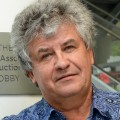NSU Newsroom
SharkBytes
Horizons
This version of NSU News has been archived as of February 28, 2019. To search through archived articles, visit nova.edu/search. To access the new version of NSU News, visit news.nova.edu.
This version of SharkBytes has been archived as of February 28, 2019. To search through archived articles, visit nova.edu/search. To access the new version of SharkBytes, visit sharkbytes.nova.edu.
Oceanographic Center Faculty and Students Present at National Conference
Earlier this year, students and faculty from the Oceanographic Center participated in a three-week field campaign in the Gulf of Mexico that examined the fate of oil that is released into the environment. The NSU participants were students Cayla Dean and Bryan Hamilton and professor Alexander Soloviev, Ph.D.
The students and Soloviev presented their research at the recent Gulf of Mexico Research Initiative (GoMRI) conference in Mobile, Alabama. Joining them was associate professor Tracey Sutton, Ph.D., who presented information on a National Oceanic and Atmospheric Administration (NOAA) research project.
Soloviev and his students were part of the Consortium for Advanced Research on Transport of Hydrocarbon in the Environment (CARTHE) research team. CARTHE, which is funded by the Gulf of Mexico Research Initiative (GoMRI), consists of several major oceanographic organizations and its purpose is to research what will help predict the fate of oil that is released into the environment and help inform and guide response teams. These predictions can help minimize oil spill damage to human health, the economy, and the environment. Data was collected using ocean drifters that were deployed in various locations and by the release of dye to track water flow patterns.
As a part of this study, the NSU group implemented new methods to sample the sea surface microlayer and subsurface water in order to determine what types of surfactant and oil associated bacteria were present. These bacteria’s can aid in the formation of sea slicks, which affect many aspects of the sea surface and can be seen in satellite imagery. Certain bacteria can also use oil as a source of energy, making these organisms important when studying the presence of oil in marine environments.



